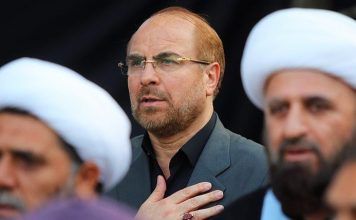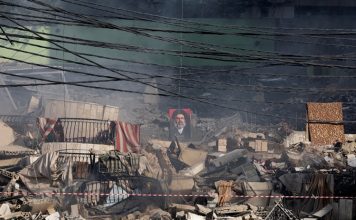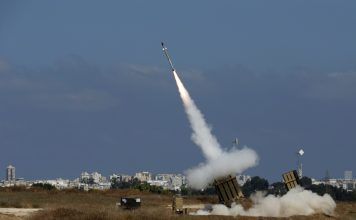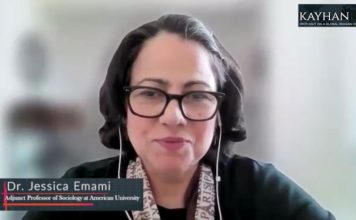The Islamic Republic of Iran’s Police Command has confirmed that Arezoo Badri, a 31-year-old mother of two, was shot in the back by officers while in her car following weeks of speculation about the incident, according to an Aug. 19 report by online newspaper Iran Wire.
The video, which was aired on Aug. 19, appeared to blame Badri for the attack, Iran Wire said.
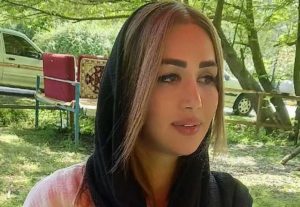
Several contradictory reports about the attack were published by the head of police in Noor city where the shooting took place and the semi-official Fars News Agency which is managed by the Islamic Revolutionary Guard Corps (IRGC).
Previous reports by Iran’s police and state media suggested the mother was shot on the evening of July 22 or July 23, during an “anti-theft operation.” Other sources who spoke to local media outlets identified Badri as the woman in the car and claimed she was targeted for breaching the republic’s forced hijab law which places a legal duty on women to wear a veil in public.
Badri’s car was shot at several times during the incident, resulting in a bullet hitting her back. She was initially taken to Noor and Sari medical centers and is now at Valiasr Hospital in Tehran, where she remains under heavy guard. Doctors removed the bullet lodged in her back, but Badri is now paralyzed from the waist down after sustaining severe lung and spinal cord damage, according to an Aug. 10 report by BBC Persian.
A video of Badri which appears to show her trying to speak during an interview with a reporter allegedly working for the IRGC-affiliated Tasnim news agency, was posted on Aug. 19 on X (formerly Twitter) by Amirhossein Miresmaeili, a France-based journalist. In the video, Badri and her father said that her condition had improved and that this was thanks to officials.
“The interrogator-reporter of Tasnim, the IRGC’s news agency, forced a confession from #آرزو_بدری [#ArezooBadri] and her father to say that Arezoo’s condition had improved and this was thanks to the authorities!” Miresmaeili said in his post. “Meanwhile it is clear in the video that Arezoo can hardly move and can hardly speak. Why? Because they shot her for opposing the mandatory hijab.”
Miresmaeili was sentenced to 10 years in prison at a tribunal in Iran in 2018 after being charged with “insulting government and judicial officials, the ‘Holy imams of Shia’ and publishing lies to disturb public opinion,” according to the International Federation of Journalists. The charges were raised after Miresmaeili posted critical posts about government officials and clerics on X while working for Jahan Sanaat, an economic newspaper in Iran. Miresmaeili left the country ahead of his appeal hearings, in 2019.
The young woman’s family have also been subjected to pressure by Iran officials, according to the report by the BBC. The family’s phones have been confiscated during hospital visit and they have been forbidden from taking photos of Badri.
Further concerns about the family’s treatment were raised in an Aug. 18 video posted on X by gender equality campaigner Masih Alinejad, which appeared to show Badri being pushed around the hospital in a gurney.
“An informed source sent me this first video from inside the heavily secured hospital, revealing that Commander Radan’s crew coerced her and her family into saying they were satisfied with the conditions, despite their strong opposition,” Alinejad said in the post.
Alinejad launched a social media campaign on Aug. 16 on her My Stealthy Freedom campaign website, calling on social media users to give a voice to Badri by posting videos of support and using the hashtags #ArezooBadri or #WhereIsArezoo.
“Will you join me in giving a voice to #ArezooBadri, paralyzed after being shot by Iran’s morality police for not covering her hair? Arezoo needs us now,” Alinejad said in the statement.
An Aug. 16 report by the human rights organization Hengaw said Badri’s car had been marked for confiscation under the offense of “not observing hijab.”
While the Islamic Republic’s mandatory dress code also sets out clothing rules for men, women have been disproportionately targeted and exposed to violence for breaching the regulations in recent decades.
Though men are very rarely detained for dress code violations and only occasionally face fines for breaches, women are routinely arrested, fined, subjected to physical and sexual assault, and killed in police custody.
Systemic violence against women in the Islamic Republic was central to the triggering of the 2022 nationwide anti-government protests, following the death of 22-year-old Mahsa Amini, who was killed while in police custody for failing to cover her hair. Amini’s death sparked the ‘Woman, Life, Freedom’ movement, which advocates for gender equality in Iran.
The increased use of excessive and lethal force against women demanding equality and failing to comply with the mandatory hijab law has drawn international condemnation from bodies such as the United Nations and international human rights groups.
“The violent repression of peaceful protests and pervasive institutional discrimination against women and girls has led to serious human rights violations by the Government of Iran, many amounting to crimes against humanity,” the UN’s Independent International Fact-Finding Mission on the Islamic Republic of Iran said in its first report published in March. “Authorities then mobilized the entire security apparatus of the State to repress the protesters who took to the streets after Ms. Amini’s death. Credible figures suggest that as many as 551 protesters were killed by the security forces, among them at least 49 women and 68 children. Most deaths were caused by firearms, including assault rifles.”
Amnesty International accused the Islamic Republic of “waging a war on women,” during the protests, in a May report. The report went on to detail the rising use against girls and women of “surveillance, beatings, sexual violence, electric shocks, arbitrary arrest and detention and other harassment,” by security forces to implement forced hijab legislation.




